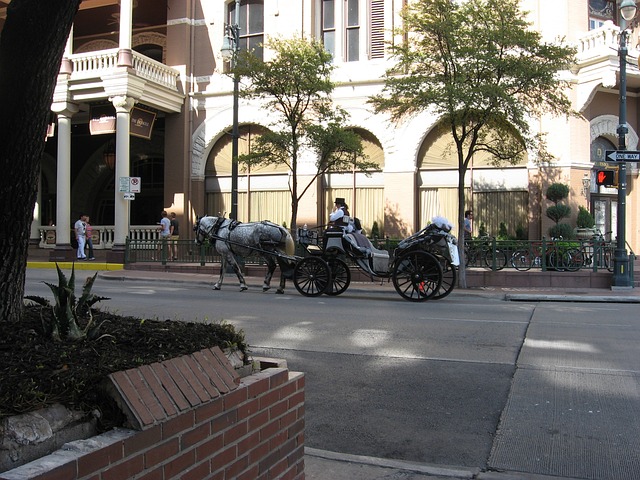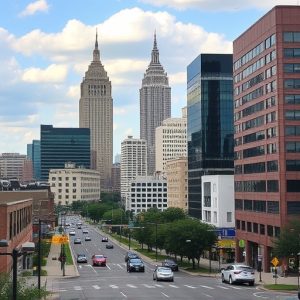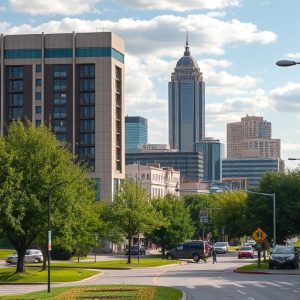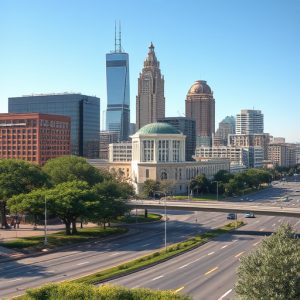Austin’s Time-Honored Landmarks: A Guide to Texas History and Heritage Sites
Austin, Texas is a city steeped in history, showcasing a mosaic of its evolution from a frontier ou…….

Austin, Texas is a city steeped in history, showcasing a mosaic of its evolution from a frontier outpost to a dynamic capital city. Key historical sites like the Texas State Capitol, an iconic pink granite landmark completed in 1888, and the Bullock Texas State History Museum, offer a deep dive into Austin's past from ancient times to the present. The University of Texas at Austin campus, with its famous tower, and the historic Driskill Hotel reflect the city's intellectual and storied legacy. Barrington Street takes visitors back to Austin's early residential days, with its 19th-century homes that exemplify the city's architectural heritage. The Pioneer Fountain and Plaza, originally Waterloo Park, commemorates Austin's pioneering female settlers and serves as a lively community hub. The Texas State Cemetery honors veterans and influential Texans who have shaped the state's history, while the Blunn Creek Nature Preserve provides a tranquil escape into Austin's natural environment. Each site enriches the visitor's understanding of Austin TX's diverse cultural, historical, and environmental tapestry, making it an engaging destination for all.
Discover the storied past of Austin, Texas, as you wander through its historical sites and landmarks, each offering a unique window into the city’s rich heritage. From the grandeur of the Capitol Complex to the serene beauty of Blunn Creek Nature Preserve, your journey will reveal layers of Austin’s history. Stroll along Barrington Street to witness Austin’s earliest residential charm, visit the Pioneer Fountain and Plaza to pay respects to the city’s founders, and honor the legacy of influential Texans at the Texas State Cemetery. Austin, TX, invites you to explore its past and appreciate its enduring spirit.
- Exploring the Rich History of Austin, Texas: A Journey Through Time
- The Capitol Complex: Austin's Architectural and Political Heartbeat
- Barrington Street: A Walk Through Austin's Earliest Residential Neighborhood
- The Pioneer Fountain and Plaza: Honoring Austin's Founding Heritage
- The Texas State Cemetery: Stories of Lives Shaped a City
- The Blunn Creek Nature Preserve: Preserving the Natural History of Austin
Exploring the Rich History of Austin, Texas: A Journey Through Time

Embarking on a historical exploration of Austin, Texas reveals a tapestry of cultural and civic growth that dates back to its inception. The city’s heritage is etched into sites like the Texas State Capitol, which stands as a testament to Austin’s importance in state governance. This grand edifice not only houses the offices of the governor but also offers visitors a glimpse into the legislative history of the Lone Star State. Austin’s past is also vividly brought to life at the Bullock Texas State History Museum, where artifacts and exhibits narrate tales from prehistoric times through to the present day. The museum serves as an anchor in understanding the evolution of Austin from a small frontier settlement into the vibrant capital city it is today.
A stroll along the grounds of the University of Texas at Austin transports one to the heart of the city’s intellectual and cultural renaissance. The campus, with its iconic tower overlooking the skyline, is steeped in tradition and history. Nearby, the Driskill Hotel is a historic landmark that has welcomed statesmen, artists, and celebrities since its opening in 1886. Each of these sites offers a unique lens through which to view Austin’s past and present, making it an enriching destination for history enthusiasts and casual visitors alike.
The Capitol Complex: Austin's Architectural and Political Heartbeat

Within the bustling city of Austin, Texas, the Capitol Complex stands as a testament to the region’s rich history and architectural prowess. This historic site is not merely a collection of buildings but is the very heartbeat of Texas’s political landscape and an embodiment of its architectural legacy. The iconic Texas State Capitol, completed in 1888, towers over the complex with its pink granite facade, symbolizing the enduring strength and beauty of Austin TX’s heritage. Visitors can explore its grand rotunda and intricate frescoes, gaining a deeper understanding of the state’s history and governance. The surrounding Capitol Complex features various buildings, each with its own story to tell, from the Texas Senate and House Chamber to the Governor’s Mansion. These structures are not just monuments to past events but active centers of government that continue to shape the lives of Texans today. A tour through this complex is a journey into the soul of Austin TX, offering a glimpse into the political forces that have shaped the Lone Star State and the architectural styles that reflect its cultural evolution over time.
Barrington Street: A Walk Through Austin's Earliest Residential Neighborhood

Stepping into Barrington Street offers a window into the early days of residential life in Austin, Texas. This historic neighborhood, nestled within the heart of the city, is home to some of the oldest homes that reflect the architectural styles and craftsmanship of the 19th century. As visitors meander along the cobblestone paths and under the sprawling oak trees, they are transported back to a time when Austin was still evolving from a frontier settlement into a bustling town. The homes lining Barrington Street tell a story of resilience and adaptation, with many structures having been restored to their original splendor, showcasing the enduring legacy of Austin’s early pioneers. A walk through this historic enclave is not just a stroll through Austin’s past; it’s an appreciation of the city’s foundational roots and the rich tapestry of history that has shaped its identity over the years. In Austin TX, Barrington Street stands as a tangible testament to the city’s growth and transformation, offering a unique perspective for both residents and visitors alike.
The Pioneer Fountain and Plaza: Honoring Austin's Founding Heritage

Austin, Texas, is a city steeped in history, and one of its most significant historical sites is The Pioneer Fountain and Plaza, located at the heart of downtown Austin. This site serves as a tangible connection to the city’s founding heritage, offering visitors a glimpse into the past. Established in 1872, the Plaza was originally known as Waterloo Park and later became the site of the Pioneer Mother Monument, dedicated in 1930. The monument, designed by Leonard P. Vinci and sculpted by Elisabet Ney, represents an idealized pioneer woman holding her infant, symbolizing the maternal spirit of Austin’s early settlers. This iconic representation is a poignant tribute to the women who played a pivotal role in the city’s growth and development.
The Pioneer Fountain and Plaza are not just relics of the past but also serve as a vibrant community gathering place, reflecting Austin’s rich history and ongoing cultural life. The area has undergone various transformations over the years, including the addition of the Texas Spirit Theater and the Bullock Texas State History Museum nearby. These contemporary additions complement the historical significance of the site, providing an educational experience that connects Austin’s past with its present. Visitors to the Pioneer Fountain and Plaza can immerse themselves in the stories of the city’s origins, appreciate the architectural beauty of the surrounding buildings, and enjoy the lively ambiance that has made downtown Austin a beloved destination for both locals and tourists alike.
The Texas State Cemetery: Stories of Lives Shaped a City

Nestled in the heart of Austin, Texas, the Texas State Cemetery stands as a silent sentinel to the city’s rich history and the lives that have shaped its past. This hallowed ground is more than just a resting place for veterans and distinguished Texans; it is a living museum where each headstone tells a story of courage, sacrifice, and contributions to the Lone Star State. Visitors can wander through the meticulously maintained landscapes, absorbing the tales etched in stone, which date back to the founding of Austin itself. The cemetery’s narrative extends beyond the mere burial of its inhabitants; it is a testament to the pivotal moments and figures that have influenced the trajectory of Austin TX from a small frontier outpost into a dynamic capital city. Here, history comes alive not just through the historical markers but also through guided tours that shed light on the interments’ significant roles in Texas’s evolution, including their part in its legal, political, and cultural development. A visit to this storied site offers an intimate connection with Austin’s heritage, inviting locals and tourists alike to honor the past while understanding the legacy left by those who have gone before.
The Blunn Creek Nature Preserve: Preserving the Natural History of Austin

Nestled within the heart of Austin, Texas, the Blunn Creek Nature Preserve stands as a testament to the city’s commitment to preserving its natural heritage. This pristine sanctuary offers visitors an immersive experience into the natural history that has shaped Austin. With over 60 acres of lush greenery and diverse ecosystems, the preserve showcases a variety of habitats, including woodlands, riparian areas, and spring-fed pools. The preserve’s trails invite exploration of the creek’s path, providing insight into the geological and ecological evolution of the region. It is a living classroom where the past and present converge, allowing residents and tourists alike to witness firsthand the biodiversity that once blanket the entire Texas landscape. Austinites take pride in this green space, recognizing it as an integral part of their city’s identity, offering a peaceful respite from urban life while safeguarding the environmental legacy of Austin, TX for generations to come. The Blunn Creek Nature Preserve is not just a park but a guardian of history, offering a clear view into the natural beauty and rich ecological tapestry that has been part of Austin’s story since time immemorial.
Exploring the historical sites and landmarks in Austin, Texas offers a captivating window into the city’s rich past. From the architectural grandeur of the Capitol Complex to the serene beauty of Blunn Creek Nature Preserve, each location imparts a unique narrative that collectively tells the story of Austin’s evolution. The Barrington Street district and the Pioneer Fountain and Plaza are poignant reminders of the city’s founding roots, while the Texas State Cemetery stands as a living monument to the influential figures who have shaped its history. These sites not only serve as a testament to Austin’s heritage but also highlight the importance of preserving both our collective past and the natural environments that have been integral to the region for centuries. In Austin, TX, history is alive, waiting to be discovered by residents and visitors alike.







